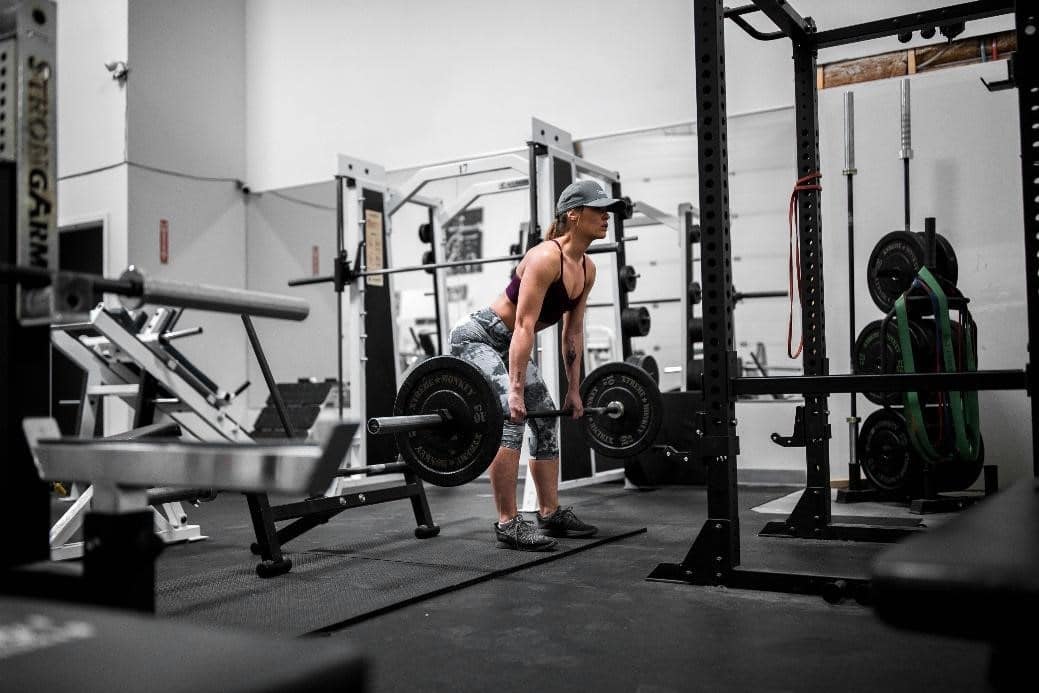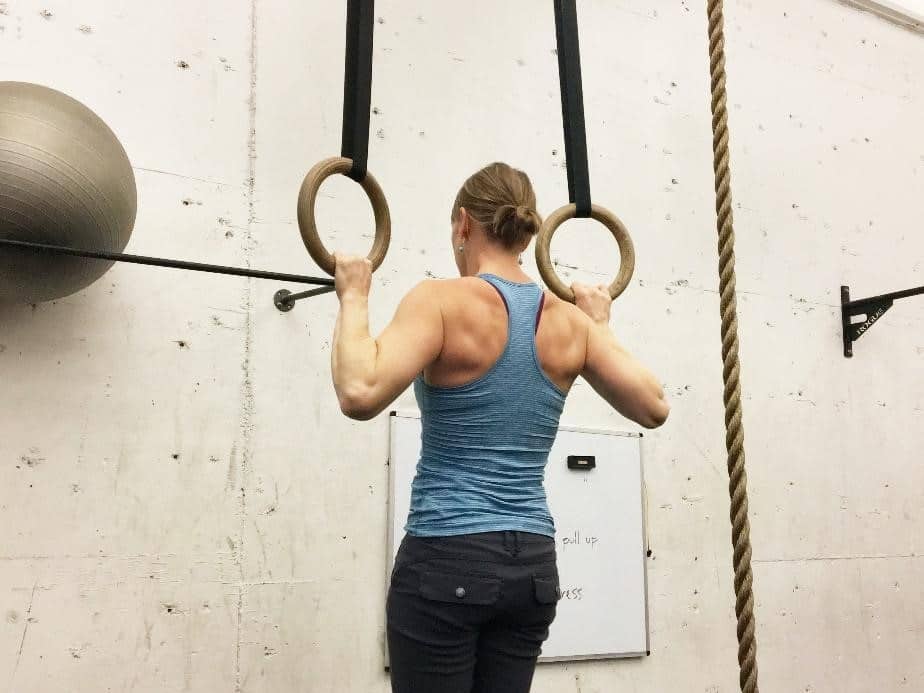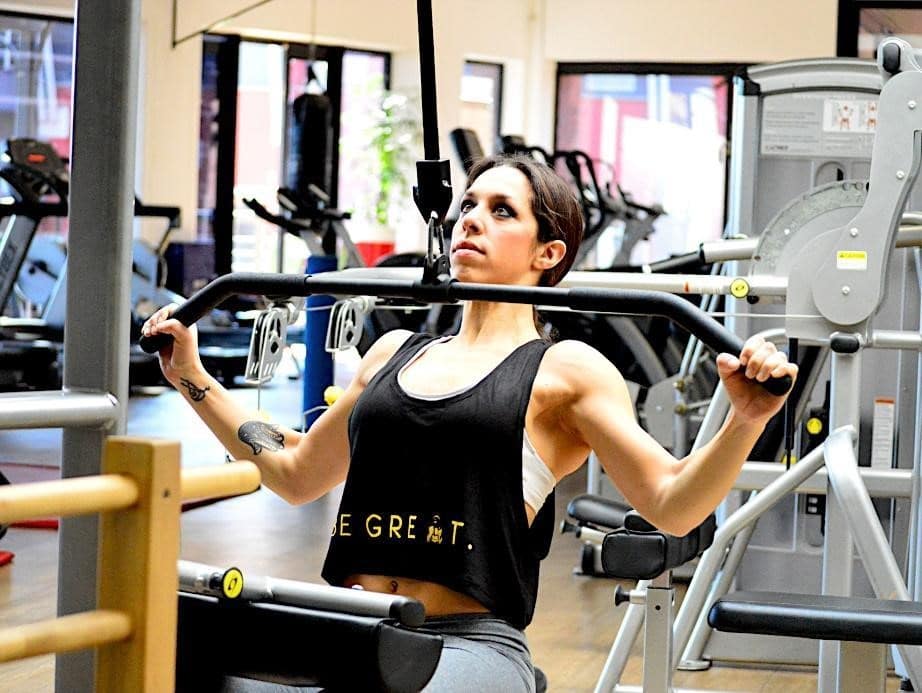30 de June de 2023
Weight Training For Weight Loss
Weight Training to Lose Weight – Still Underrated
An analysis of twelve systematic reviews and 149 studies published in the prestigious Obesity Reviews highlights the three key pillars to keep in mind when formulating a weight loss training strategy (Bellicha et al., 2021):
“Aerobic training is more effective than weight training for weight loss”. We will see in this article that the goal is not weight, but body composition.

“High-intensity interval training (HIIT) is as effective as moderate-intensity continuous training if the session involves the same energy expenditure.” HIIT shortens the duration of resistance work, leaving plenty of room for weight training to lose weight.
“Weight training is the most effective exercise modality for preserving lean body mass.” The goal of the weight loss process is to improve body composition, not weight itself. That mistake explains why many studies consider weight training insufficient for weight loss. We will detail why we have misunderstood the science in this regard.
Why stick with one training modality if we can select the best of each? Until recently, weight loss was sought through diet, regardless of the type of physical exercise performed, if any, as many people based their process solely on diet. Gradually we came to understand that the indispensable factor for weight loss is to consume more calories than we consume, which is known as energy deficit or caloric deficit (Strasser et al., 2007). If we ingest more calories than we expend over the course of the day, the opposite happens: we gain weight.
Based on this accurate, but incomplete theory, we were to look for exercise modalities that expended a lot of energy and diets that provided fewer calories than those we had consumed. The CICO (Calories In, Calories Out) diet applies that rationale, but forgets many of the factors that go into successful weight loss over time (Paoli et al., 2017). There is still a lot of the population that continues to put scale weight as the cornerstone in their goal to improve their body composition, but there is a message that is increasingly permeating: losing weight is different from losing fat.
Weight training for weight loss has been embraced by gym users recently, because until that time, we still considered diet alone, or diet with aerobic training, as the key pieces of the weight loss puzzle. Scientific evidence considers weight training to have an ineffective role in reducing weight or body mass index (BMI) (Oppert et al., 2021). However, although body weight and BMI are important and widely used in clinical practice, they do not differentiate between fat mass and muscle mass, which means that the potential use of strength training has not been properly exploited in past stages (Morze et al., 2021).
Weight Training is The Starting Point to Lose Weight

Weight training for weight loss is an effective option for maintaining muscle mass, and even increasing it, while decreasing fat mass (Lopez et al., 2022). In addition, the intense muscle contraction generated in strength sessions promotes a much healthier cellular environment, especially in people with obesity, who have altered metabolic functions. Myostatin, interleukin six and brain-derived neurotrophic factor are released in such muscle contraction, and serve as protection against proinflammatory adipokines that are activated when we accumulate excessive fat (Pedersen & Febbraio, 2012). Therefore, the maintenance or improvement of muscle mass, which occurs with strength training, but not so much with resistance training, accrues clinical benefits that turn our body into a more efficient machine when it comes to oxidizing fat (Westcott, 2012).
Lifting Weights Should be Mandatory for Women and Seniors to Lose Weight
A quite common mistake when going through a weight loss process is to go on an overly restrictive diet, which is usually accompanied by starting, or increasing, the practice of physical exercise. This explosive mixture can cause us to wipe out our muscle mass and also take away some of our bone mineral density (McCarthy & Berg, 2021). Depending on our age and gender, that situation can be easily reversed, or not reversed at all.
Women have two significant differences from men: their potential to gain absolute muscle mass and the loss of bone mineral density from menopause onward. A woman in her sixties who wants to lose weight must take great care of her muscle and bone mass, as failure to do so can damage her health for decades to come. The way to lose fat, not weight, and maintain bone health, even improve it, is strength training accompanied by sufficient protein intake (Longland et al., 2016; Martin-Rincon et al., 2019). If that same 60-year-old woman goes on a strict diet, and does not lift weights, her outcome will be vastly different.
Resistance Training Isn’t The Main Role

An hour of running will consume more calories than an hour of strength training, no doubt about it. By consuming more calories, it will be easier to generate the energy deficit that is essential for weight loss, there is no doubt about that either. There is no doubt either that what really matters is the fat lost, not the weight, and that is where weight training for weight loss makes its stellar appearance. In fact, resistance training is optional, not mandatory, but weight training for weight loss is mandatory, not optional (Martin-Rincon et al., 2019).
NEAT (Non-Exercise Activity Thermogenesis) is a fundamental factor in body rebuilding that is highly underappreciated (Chung et al., 2018). NEAT encompasses the physical activity we do throughout the day, which are all those daily tasks that consume energy outside of physical exercise: walking to work, walking up the stairs at home, cleaning the apartment, etc. Increase NEAT as much as you can, and it will be much more effective than cardio for weight loss (Loeffelholz & Birkenfeld, 2022).
HIIT: Same Results in Less Time
High-intensity interval training (HIIT) is an exercise modality that achieves in a few minutes a calorie consumption similar to what we would do in much more time at low or moderate intensity (D’Amuri et al., 2021). Given the lack of time, which is often the main excuse for training less, introducing HIIT at the end of the weight training session, or during it, will lead us to the same goal as going for a one-hour run (Guo et al., 2023). In addition, HIIT is much more entertaining than the monotony of walking or running for hours (Viana et al., 2019).
Weightlifting + HIIT + Healthy Diet = Winning Cocktail for Fat Loss & Better Body
Weight training for weight loss has been underestimated over the decades, although scientific evidence has long pointed to its potential (Bellicha et al., 2021; Lopez et al., 2022). Today we know that, if we want to lose fat and improve body composition, the best strategy is to train strength, add some HIIT sessions, increase NEAT as much as possible, follow a diet rich in protein and with a slight energy deficit, and after doing all that, complement it with resistance training (Bellicha et al., 2021; McCarthy & Berg, 2021; Strasser et al., 2007).
If your goal is to “lose weight”, it will suffice to go on any diet in which you eat fewer calories than you expend. Such a diet can even be based on pizza and French fries, as long as the sum of calories is less than what you spend during the day. With this strategy you will lose weight, but we don’t know how much fat you will oxidize along the way, nor how much muscle mass you will drag down in the process, as well as the possible loss of bone mineral density. In short: weight training will improve your body composition, which is the real goal to achieve.
Weight Training Exercises to Lose Fat

The type of weight training exercises used to lose weight will depend on your athletic level, lifestyle, days you train and the diet you follow. The general recommendation is that exercises should be multi-joint to stimulate a lot of muscle mass at once (Paoli et al., 2017). This recommendation includes exercises such as Olympic lifts or deadlifts, but these movements are overly complex technically, so they are not available to everyone. Below, we propose some of the exercises, or groups of exercises, which cannot be missing in your weight training to lose weight.
Dumbbell Power Snatch
Explosive movements, such as the Olympic movements, are remarkably interesting for fat loss because they involve a large part of the body’s musculature, in addition to requiring an explosive contraction of the muscles, which also helps in the objective. The one-handed dumbbell pull-up (video above) is one of the variations of the Olympic movements that are suitable for most people, unlike a Bar Snatch or a clean.
Squat, Bench Press, Deadlift: Powerlifting Basics and Variations
Powerlifting uses three basic exercises in competition: Back squat, bench press and classic deadlift. These three movements involve a lot of muscle mass at once, and have a long list of variations that can be used as well. Instead of the back squat, you can also use a goblet squat (video above) or a Bulgarian squat; alternate the barbell flat bench press with push-ups on the floor or some horizontal machine thrusts; and modify the conventional deadlift with a Romanian deadlift or a hex bar deadlift. The goal of these exercises is to activate a lot of muscle mass with a single movement.
Bulgarian Split-Squat & Other Single Leg Exercises
When we are in energy deficit, we do not have the same energy as when we ingest more calories. That makes some exercises like those in the previous section (squats, deadlifts …) are limited and we see how our marks decrease. To solve this problem, train with exercises like the Bulgarian squat (video above) and other options performed on one leg. Among these options are single leg deadlift, single leg hip-thrusts, lunges, step-up and all similar exercises. With these movements the perception of effort will be less, but we will be stimulating our musculature in the same way as with exercises performed with both legs at the same time.
Pulls: Rows & Pull-Ups
Exercises in which you pull a load towards you are known as pull-ups, and involve the back musculature and the elbow and wrist flexors (biceps and forearm). Inverted rows are easier exercises than pull-ups (video above), as we pull a smaller amount of weight. These movements can also be performed on machines or with free weights, all of which will promote muscle mass retention, and can even increase it if you are new to strength training.
Strengthen Your Abs… Although These are Uncovered in The Kitchen
The Turkish get-up (video above), barbell rollout, planks and a long list of core exercises should be introduced into your weight training to lose weight. No matter how many crunches you do, they won’t be visible until the abdominal fat covering them is removed. Hence comes the saying “abs are done in the kitchen”, although really abdominal muscles are done in the gym and uncovered in the kitchen.
Machines For Losing Fat

The choice of exercises is determined by the amount of time you can devote to the gym. When we have little time, we should prioritize the multi-joint exercises highlighted so far. If we have a little more time, we can dedicate time to stimulate more deeply certain muscles that we isolate with the use of one machine or another. The energy expenditure of the exercise will be less, but the individual activation of certain groups will be greater.
The same is true for muscle group exercises such as biceps, triceps or calves, which stimulate a smaller muscle area, but increase their participation. These muscle groups work indirectly by executing more global options: biceps work alongside the back in pull-ups; triceps work on chest thrusts like the bench press; and the calves help in leg exercises. However, you should make extra time to spend directly on these muscle groups.
Strength & Conditioning: Introducing HIIT
Exercises such as burpees make us shoot our heart rate in a matter of seconds, while we are working on our push-ups. Other movements like mountain climbers make us work our endurance while we feel the contraction of our abdomen. Some exercise combos like thrusters will make us sweat in a minute and bring our legs and shoulders to fatigue at that same time.
There are many other exercises such as sumo deadlift high pull, which work on strength while significantly increasing caloric expenditure. These options are interesting to introduce at the end of the strength session as HIIT, since in this way we continue to work strength and increase calorie expenditure. However, it is said that he who grasps all, grasps little, and these combinations of exercises, although they are amazingly effective as finishers, should not be done exclusively during weight training to lose weight. It is better to use the exercise groups described in the previous sections.
Joaquín Vico Plaza
References
Bellicha, A., van Baak, M. A., Battista, F., Beaulieu, K., Blundell, J. E., Busetto, L., Carraça, E. V., Dicker, D., Encantado, J., Ermolao, A., Farpour-Lambert, N., Pramono, A., Woodward, E., & Oppert, J. M. (2021). Effect of exercise training on weight loss, body composition changes, and weight maintenance in adults with overweight or obesity: An overview of 12 systematic reviews and 149 studies. Obesity Reviews, 22(Suppl 4). https://doi.org/10.1111/OBR.13256
Chung, N., Park, M.-Y., Kim, J., Park, H.-Y., Hwang, H., Lee, C.-H., Han, J.-S., So, J., Park, J., & Lim, K. (2018). Non-exercise activity thermogenesis (NEAT): a component of total daily energy expenditure. Journal of Exercise Nutrition & Biochemistry, 22(2), 23. https://doi.org/10.20463/JENB.2018.0013
D’Amuri, A., Sanz, J. M., Capatti, E., Di Vece, F., Vaccari, F., Lazzer, S., Zuliani, G., Dalla Nora, E., & Passaro, A. (2021). Effectiveness of high-intensity interval training for weight loss in adults with obesity: a randomised controlled non-inferiority trial. BMJ Open Sport & Exercise Medicine, 7(3). https://doi.org/10.1136/BMJSEM-2020-001021
Guo, Z., Li, M., Cai, J., Gong, W., Liu, Y., & Liu, Z. (2023). Effect of High-Intensity Interval Training vs. Moderate-Intensity Continuous Training on Fat Loss and Cardiorespiratory Fitness in the Young and Middle-Aged a Systematic Review and Meta-Analysis. International Journal of Environmental Research and Public Health, 20(6), 4741. https://doi.org/10.3390/IJERPH20064741
Loeffelholz, C. von, & Birkenfeld, A. L. (2022). Non-Exercise Activity Thermogenesis in Human Energy Homeostasis. Endotext. https://www.ncbi.nlm.nih.gov/books/NBK279077/
Longland, T. M., Oikawa, S. Y., Mitchell, C. J., DeVries, M. C., & Phillips, S. M. (2016). Higher compared with lower dietary protein during an energy deficit combined with intense exercise promotes greater lean mass gain and fat mass loss: a randomized trial. The American Journal of Clinical Nutrition, 103(3), 738–746. https://doi.org/10.3945/AJCN.115.119339
Lopez, P., Taaffe, D. R., Galvão, D. A., Newton, R. U., Nonemacher, E. R., Wendt, V. M., Bassanesi, R. N., Turella, D. J. P., & Rech, A. (2022). Resistance training effectiveness on body composition and body weight outcomes in individuals with overweight and obesity across the lifespan: A systematic review and meta‐analysis. Obesity Reviews, 23(5). https://doi.org/10.1111/OBR.13428
Martin-Rincon, M., Pérez-López, A., Morales-Alamo, D., Perez-Suarez, I., de Pablos-Velasco, P., Perez-Valera, M., Perez-Regalado, S., Martinez-Canton, M., Gelabert-Rebato, M., Juan-Habib, J. W., Holmberg, H. C., & Calbet, J. A. L. (2019). Exercise Mitigates the Loss of Muscle Mass by Attenuating the Activation of Autophagy during Severe Energy Deficit. Nutrients, 11(11). https://doi.org/10.3390/NU11112824
McCarthy, D., & Berg, A. (2021). Weight Loss Strategies and the Risk of Skeletal Muscle Mass Loss. Nutrients, 13(7). https://doi.org/10.3390/NU13072473
Morze, J., Rücker, G., Danielewicz, A., Przybyłowicz, K., Neuenschwander, M., Schlesinger, S., & Schwingshackl, L. (2021). Impact of different training modalities on anthropometric outcomes in patients with obesity: A systematic review and network meta-analysis. Obesity Reviews : An Official Journal of the International Association for the Study of Obesity, 22(7). https://doi.org/10.1111/OBR.13218
Oppert, J. M., Bellicha, A., van Baak, M. A., Battista, F., Beaulieu, K., Blundell, J. E., Carraça, E. V., Encantado, J., Ermolao, A., Pramono, A., Farpour-Lambert, N., Woodward, E., Dicker, D., & Busetto, L. (2021). Exercise training in the management of overweight and obesity in adults: Synthesis of the evidence and recommendations from the European Association for the Study of Obesity Physical Activity Working Group. Obesity Reviews : An Official Journal of the International Association for the Study of Obesity, 22 Suppl 4(Suppl 4). https://doi.org/10.1111/OBR.13273
Paoli, A., Gentil, P., Moro, T., Marcolin, G., & Bianco, A. (2017). Resistance Training with Single vs. Multi-joint Exercises at Equal Total Load Volume: Effects on Body Composition, Cardiorespiratory Fitness, and Muscle Strength. Frontiers in Physiology, 8(DEC), 1105. https://doi.org/10.3389/FPHYS.2017.01105
Pedersen, B. K., & Febbraio, M. A. (2012). Muscles, exercise and obesity: skeletal muscle as a secretory organ. Nature Reviews. Endocrinology, 8(8), 457–465. https://doi.org/10.1038/NRENDO.2012.49
Strasser, B., Spreitzer, A., & Haber, P. (2007). Fat loss depends on energy deficit only, independently of the method for weight loss. Annals of Nutrition & Metabolism, 51(5), 428–432. https://doi.org/10.1159/000111162
Viana, R. B., Naves, J. P. A., Coswig, V. S., De Lira, C. A. B., Steele, J., Fisher, J. P., & Gentil, P. (2019). Is interval training the magic bullet for fat loss? A systematic review and meta-analysis comparing moderate-intensity continuous training with high-intensity interval training (HIIT). British Journal of Sports Medicine, 53(10), 655–664. https://doi.org/10.1136/BJSPORTS-2018-099928
Westcott, W. L. (2012). Resistance training is medicine: effects of strength training on health. Current Sports Medicine Reports, 11(4), 209–216. https://doi.org/10.1249/JSR.0B013E31825DABB8

